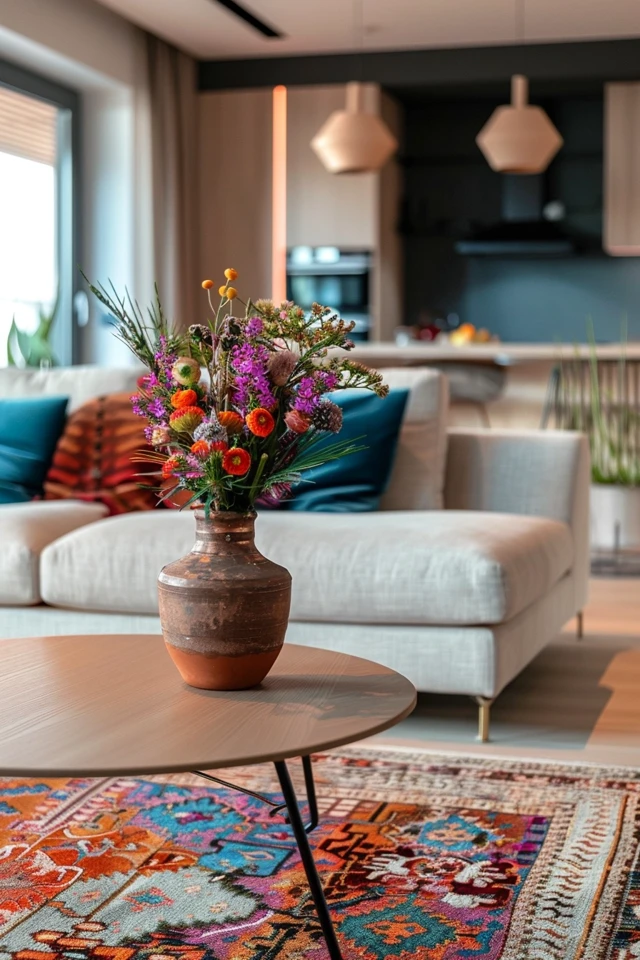Welcome to a comprehensive guide on coordinating area rugs in adjoining rooms or in open floor plans. In this section, we’ll explore various rug styles, textures, and color schemes to help you master the art of rug coordination. We’ll also provide tips on rug placement for different areas of your home and how to create a visually connected and cohesive look with your rugs and furniture.
Key Takeaways:
- Consider the colors and patterns of both the rug and furniture when coordinating.
- Choose complementary colors for a cohesive look or contrasting colors for a bold statement.
- Mix and match rugs with different patterns, as long as they share a similar color palette.
- Texture and material play a crucial role in rug-furniture pairing.
- Natural fiber rugs like sisal or jute can add texture and blend well with different decorating styles.
Tips for Coordinating Rug Colors and Patterns
When it comes to creating a cohesive look with your rugs and furniture, one of the key elements to consider is coordinating the colors and patterns. By carefully selecting the right rug colors and patterns, you can enhance the overall aesthetic of your space and achieve a harmonious design.
Coordinating Rug Colors:
When choosing rug colors, you have two options: complementary colors or contrasting colors. Complementary colors are colors that are opposite each other on the color wheel and create a harmonious effect. For example, if your furniture has warm tones like brown or beige, you can choose a rug with cool tones like blue or green to create a balanced look.
On the other hand, if you want to make a bold statement and add visual interest to your space, you can opt for rugs with contrasting colors. Rugs with contrasting colors can create a focal point in your room and add a pop of color. For example, if your furniture is mostly neutral, you can choose a rug with vibrant colors like red or yellow to create a striking visual impact.

Matching Rug Patterns:
When it comes to matching rug patterns, you have the freedom to mix and match as long as you maintain a cohesive look. It’s important to consider the overall style of your room and the existing color scheme when selecting rugs with different patterns.
One way to ensure coordination is by choosing rugs with patterns that share a similar color palette. For example, if your furniture has floral patterns in shades of blue and white, you can choose a rug with a geometric pattern that incorporates those colors. This will create a visual connection between the rug and the furniture.
Another approach is to vary the scales of patterns. If your furniture has large-scale patterns, you can choose a rug with small-scale patterns to create contrast and add visual interest. Conversely, if your furniture has small-scale patterns, you can opt for a rug with large-scale patterns to create a dynamic and eye-catching look.
Remember, the goal is to create a cohesive and visually pleasing design. By coordinating rug colors and patterns with your furniture, you can achieve a harmonious and inviting atmosphere in your space.
I love the way a well-coordinated rug can transform a room. By carefully choosing rug colors and patterns that complement or contrast with your furniture, you can create a visually stunning space that reflects your personal style.

The Importance of Texture and Material in Rug-Furniture Pairing
When it comes to coordinating rugs with furniture, the texture and material of the rug play a crucial role. The right choice can enhance the overall aesthetic and create a harmonious and inviting environment in your home.
Natural fiber rugs, such as sisal or jute, are a popular option. They add a unique texture that can blend well with various decorating styles and color schemes. These rugs bring a touch of warmth and earthiness to the room, creating a cozy atmosphere. Their versatile nature makes them suitable for both casual and formal spaces.
On the other hand, if you’re looking for a luxurious feel and long-lasting durability, wool rugs are an excellent choice. They offer a soft and plush texture that feels wonderful underfoot. Wool rugs also come in a wide range of patterns and designs, allowing you to find the perfect match for your furniture.
Layering rugs is another technique that adds depth and dimension to a room. By mixing different textures and patterns, you can create visual boundaries between spaces and add visual interest. For example, layering a natural fiber rug over a jute rug can create a stunning contrast that elevates the overall design.
When selecting rugs for your furniture, consider the pile heights, weave, and materials of both the rug and the furniture. Aim for a cohesive look by coordinating the textures and materials. This will help create a visual harmony and ensure that your rug and furniture complement each other perfectly.


